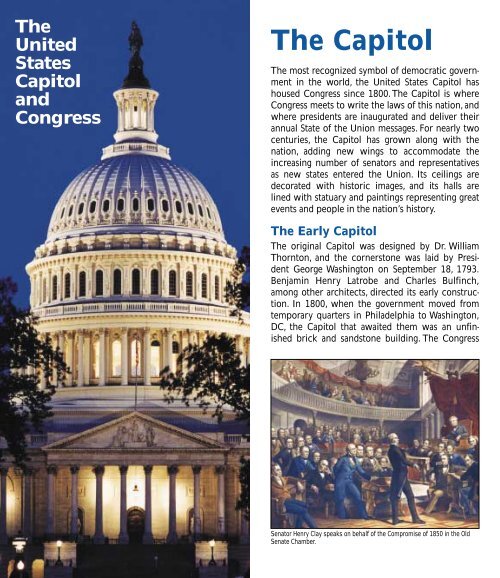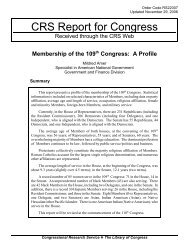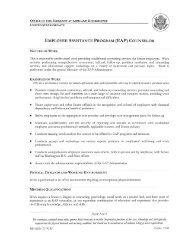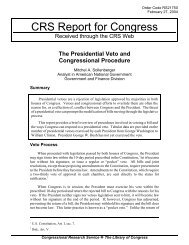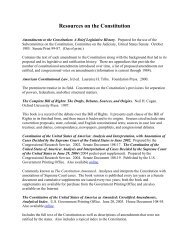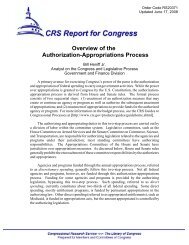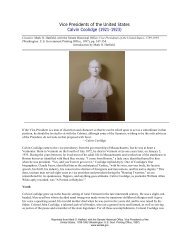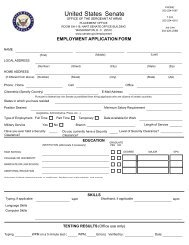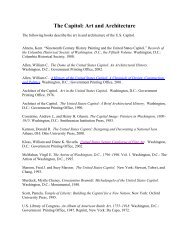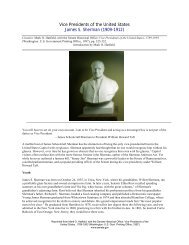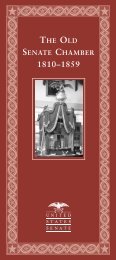The Capitol
The Capitol
The Capitol
Create successful ePaper yourself
Turn your PDF publications into a flip-book with our unique Google optimized e-Paper software.
<strong>The</strong><br />
United<br />
States<br />
<strong>Capitol</strong><br />
and<br />
Congress<br />
<strong>The</strong> <strong>Capitol</strong><br />
<strong>The</strong> most recognized symbol of democratic government<br />
in the world, the United States <strong>Capitol</strong> has<br />
housed Congress since 1800. <strong>The</strong> <strong>Capitol</strong> is where<br />
Congress meets to write the laws of this nation, and<br />
where presidents are inaugurated and deliver their<br />
annual State of the Union messages. For nearly two<br />
centuries, the <strong>Capitol</strong> has grown along with the<br />
nation, adding new wings to accommodate the<br />
increasing number of senators and representatives<br />
as new states entered the Union. Its ceilings are<br />
decorated with historic images, and its halls are<br />
lined with statuary and paintings representing great<br />
events and people in the nation’s history.<br />
<strong>The</strong> Early <strong>Capitol</strong><br />
<strong>The</strong> original <strong>Capitol</strong> was designed by Dr. William<br />
Thornton, and the cornerstone was laid by President<br />
George Washington on September 18, 1793.<br />
Benjamin Henry Latrobe and Charles Bulfinch,<br />
among other architects, directed its early construction.<br />
In 1800, when the government moved from<br />
temporary quarters in Philadelphia to Washington,<br />
DC, the <strong>Capitol</strong> that awaited them was an unfinished<br />
brick and sandstone building. <strong>The</strong> Congress<br />
Senator Henry Clay speaks on behalf of the Compromise of 1850 in the Old<br />
Senate Chamber.
moved into the small, cramped north wing. At first,<br />
the House met in a large room on the second floor<br />
intended for the Library of Congress; the Senate met<br />
in a chamber on the ground floor. Between 1810<br />
and 1859, the Senate used a chamber on the second<br />
floor, now known as the Old Senate Chamber.<br />
<strong>The</strong> Old Hall of the House of Representatives, as painted by Samuel F.B.<br />
Morse, in the collection of <strong>The</strong> Corcoran Gallery of Art.<br />
In 1807, the south wing of the <strong>Capitol</strong> was completed<br />
for the House of Representatives.A wooden<br />
walkway across the vacant yard intended for the<br />
domed center building linked the House and Senate<br />
wings. This was how the <strong>Capitol</strong> appeared in<br />
August 1814, during America’s second war with<br />
Great Britain, when British troops burned the <strong>Capitol</strong><br />
and other public buildings in Washington. <strong>The</strong><br />
exterior walls survived, but much of the interior<br />
was gutted. In 1819, the reconstructed wings of the<br />
<strong>Capitol</strong> were reopened. <strong>The</strong> center building, completed<br />
in 1826, joined the two wings. A low wood<br />
and copper dome covered the Rotunda.<br />
<strong>Capitol</strong> Extensions and Dome<br />
By 1850, so many new states had been admitted<br />
to the Union that the House and Senate had outgrown<br />
their chambers. It was decided to enlarge the<br />
<strong>Capitol</strong> by adding grand wings to the ends of the<br />
original building. In 1851, Daniel Webster, who had<br />
served in both houses of Congress, delivered one of<br />
his famous orations<br />
at the laying<br />
of the cornerstone<br />
for the new<br />
wings. <strong>The</strong> House<br />
occupied its current<br />
chamber in<br />
1857, and the Senate<br />
moved into its<br />
chamber in 1859.<br />
<strong>The</strong> Old Hall of<br />
the House was<br />
later dedicated as<br />
National Statuary<br />
Hall. Congress<br />
invited each state<br />
to contribute two<br />
statues of its most<br />
notable citizens.<br />
<strong>The</strong> Old Hall of the House now serves as<br />
National Statuary Hall.<br />
Today, these statues are displayed in Statuary Hall<br />
and in corridors throughout the building.<br />
During the Civil War, work continued on the<br />
new cast-iron dome, designed by Thomas U.Walter.<br />
On December 2, 1863, the Statue of Freedom, by<br />
American artist Thomas Crawford, was placed at the<br />
top of the dome, 287 feet above the East Plaza.<br />
In the 1870s, landscape architect Frederick Law<br />
Olmsted designed the terraces that run across the<br />
north, south, and west elevations of the <strong>Capitol</strong>.<br />
<strong>The</strong>se terraces provided extra rooms as well as a<br />
grand pedestal for the building perched on the<br />
brow of <strong>Capitol</strong> Hill.<br />
20th-Century Changes<br />
By the opening of the twentieth century, the need<br />
for more space again became acute.<strong>The</strong> first House<br />
and Senate office buildings were finished in 1908<br />
and 1909, respectively.Tunnels and electric subway<br />
cars connect these buildings with the <strong>Capitol</strong>.<br />
Severe deterioration of the original sandstone<br />
walls prompted major renovations of the <strong>Capitol</strong>’s<br />
exterior. Between 1958 and 1962 the East Front was<br />
extended thirty-two feet and the original facade<br />
replicated in marble. Portions of the old outside<br />
walls can still be viewed inside the East Front corri-
dors. In the 1980s, the West Front was carefully<br />
repaired and restored; it is the only portion of the<br />
original exterior not covered by marble additions.<br />
<strong>The</strong> Rotunda<br />
<strong>The</strong> Rotunda is the very heart of the <strong>Capitol</strong>.<br />
Although it serves no legislative function, it is a ceremonial<br />
center where state funerals have been held<br />
for presidents beginning with Abraham Lincoln,<br />
distinguished members of Congress, military<br />
heroes, and eminent citizens.Visiting heads of state<br />
have been received in the Rotunda, and memorable<br />
individuals and events celebrated.<br />
Hanging in the Rotunda are four giant canvases<br />
painted by John Trumbull, an aide-de-camp to General<br />
Washington, who recorded scenes of the American<br />
Revolution. Four other artists added paintings<br />
depicting events<br />
associated with the<br />
discovery and settlement<br />
of the United<br />
States. On<br />
the canopy,<br />
suspended<br />
180 feet<br />
above the<br />
Rotunda<br />
floor, the<br />
Italian-<br />
American<br />
artist Constantino<br />
Brumidi<br />
painted <strong>The</strong><br />
Apotheosis of<br />
Washington. It depicts<br />
´<br />
Constantino Brumidi painted<br />
<strong>The</strong> Apotheosis of Washington inside the<br />
<strong>Capitol</strong> dome<br />
in 1865.<br />
George Washington surrounded by symbols of<br />
American democracy and technological progress.<br />
Brumidi painted and decorated many of the rooms<br />
and corridors of the <strong>Capitol</strong>, and he was painting<br />
the frieze that rings the Rotunda when he died.<br />
Other artists completed his work, which illustrates<br />
major events in the nation’s history.<br />
Help preserve the <strong>Capitol</strong>’s art treasures for<br />
future generations. Please look at and enjoy, but do<br />
not touch, the paintings and sculptures.<br />
A view of the <strong>Capitol</strong> in<br />
1800 with only the north<br />
wing completed (left).<br />
<strong>The</strong> first known photograph<br />
of the <strong>Capitol</strong> in<br />
1846 (middle left).<br />
<strong>The</strong> Statue of Freedom<br />
tops the dome (above).<br />
Construction of the new<br />
cast-iron dome in 1861<br />
(left).<br />
Presidential Inaugurations<br />
have taken place at the<br />
<strong>Capitol</strong> since 1801. Seen<br />
here is Calvin Coolidge’s<br />
Inauguration in 1925<br />
(below).<br />
106th Congress, 2d Session, Senate Document 106–24 (R)
<strong>The</strong> Congress<br />
<strong>The</strong> chief focus of the <strong>Capitol</strong> is on the chambers<br />
of the Senate and House of Representatives. Here<br />
members introduce legislation; speak out on the<br />
issues; and cast votes on bills, resolutions, nominations,<br />
and treaties. A series of buzzers and lights<br />
throughout the <strong>Capitol</strong> and office buildings summon<br />
members to vote. <strong>The</strong> House chamber is in<br />
the south wing of the <strong>Capitol</strong>; the Senate chamber<br />
is in the north wing.<br />
Galleries in both houses have been set aside for<br />
the print and broadcast media, and in recent years<br />
floor proceedings have been televised. Except<br />
on rare occasions, proceedings of the Senate and<br />
House and their committees are open to the press<br />
and public. News of congressional activities is<br />
broadcast instantly around the world from the<br />
<strong>Capitol</strong>, and visitors will often see cameras and<br />
reporters outside the building, using the <strong>Capitol</strong><br />
dome as their backdrop.<br />
years. Senators are elected for six-year terms, onethird<br />
of the Senate being elected every two years.<br />
Originally senators were chosen by state legislators,<br />
but in 1913 the Seventeenth Amendment provided<br />
for direct election of senators by the people.<br />
If a senator dies or leaves office in midterm, the<br />
governor of the state may appoint a replacement.<br />
<strong>The</strong> vice president is the presiding officer of the<br />
Senate, but on a daily basis the chair is usually held<br />
by the president pro tempore of the Senate (the<br />
senior member of the majority party) or a designee.<br />
<strong>The</strong> vice president votes only to break a tie.<br />
<strong>The</strong> House of Representatives<br />
<strong>The</strong> House of Representatives, under a law passed<br />
in 1911, is limited to 435 members. States are<br />
assigned a number of representatives based on<br />
their population and are redistricted every ten<br />
years after the census. Each state is entitled to at<br />
<strong>The</strong> Senate<br />
<strong>The</strong> Senate has 100 members, two from each state.<br />
A senator must be thirty years of age, a resident of<br />
the state, and a citizen of the United States for nine<br />
<strong>The</strong> chamber of the House of Representatives.<br />
<strong>The</strong> Senate chamber.<br />
least one representative. If a representative dies or<br />
leaves office in midterm, a special election is held<br />
to choose a replacement. In addition, non-voting<br />
delegates represent American Samoa, the District of<br />
Columbia, Guam, and the Virgin Islands; Puerto Rico<br />
is represented by a resident commissioner.<br />
A representative must be twenty-five years of<br />
age, a resident of the state, and a citizen of the
United States for at least seven years. Members of<br />
the House of Representatives serve two-year terms.<br />
<strong>The</strong> presiding officer of the House is the Speaker.<br />
<strong>The</strong> Speaker is next in line after the vice president<br />
to succeed to the presidency.<br />
Special Powers<br />
Under the constitutional system of checks and<br />
balances, federal powers are both shared and divided<br />
among the legislative, executive, and judicial<br />
branches of government, as well as between the<br />
two houses of Congress. <strong>The</strong> Constitution gives<br />
both the Senate and House responsibility for declaring<br />
war, maintaining the armed forces, assessing<br />
taxes, borrowing money, minting currency, regulating<br />
commerce, and making all laws necessary for<br />
the operation of the government.<strong>The</strong> Senate alone<br />
offers advice and consent on treaties and nominations.<br />
<strong>The</strong> House of Representatives initiates all<br />
“money” bills (taxation and appropriation measures);<br />
the Senate may vote changes in such bills,<br />
and any differences are then resolved in conference<br />
between the House and Senate.<strong>The</strong> House votes on<br />
articles of impeachment (an indictment of the president<br />
or other federal officer), and the Senate judges<br />
whether or not to remove the individual from office.<br />
Visitor Information<br />
Visitors are encouraged to tour the <strong>Capitol</strong>, view<br />
its artwork and historic rooms, spend time in the<br />
galleries, and visit the offices of their senators and<br />
representatives. Congress is proud to maintain the<br />
<strong>Capitol</strong> as a building with few restrictions on visitors.<strong>The</strong><br />
<strong>Capitol</strong> is open seven days a week, except<br />
Thanksgiving, Christmas, and New Year’s Day. For<br />
information on hours and tours call (202) 225–6827.<br />
When the Senate and House are in session, passes<br />
are necessary for admission to the chamber galleries.<br />
Visitors may obtain passes from their representative<br />
or senators. Foreign visitors may obtain<br />
House passes at the House appointment desk on<br />
the first floor and Senate passes at the Senate<br />
appointment desk, also on the first floor.Tours and<br />
assistance for persons with disabilities are available<br />
from the Congressional Special Services Office, in<br />
<strong>The</strong> Rotunda is a highlight of a visit to the <strong>Capitol</strong>.<br />
the first-floor central area known as the Crypt; for<br />
tour information call (202) 224–4048.<br />
Materials providing additional information about<br />
the <strong>Capitol</strong> and the Congress are available at gift<br />
stands on the first floor. On the Internet information<br />
is available at the House and Senate websites:<br />
http://www.house.gov and http://www.senate.gov.<br />
Citizens of the United States who have specific<br />
questions about the <strong>Capitol</strong> or Congress are<br />
encouraged to write to either of their<br />
senators (Washington, DC 20510) or their representative<br />
(Washington, DC 20515).<br />
Members’ Offices<br />
Offices of representatives are located in the three<br />
buildings on the south side of the <strong>Capitol</strong> along<br />
Independence Avenue: the Cannon, Longworth,<br />
and Rayburn Buildings. Senators have offices in the<br />
three buildings on the north side of the <strong>Capitol</strong><br />
along Constitution Avenue: the Russell, Dirksen,<br />
and Hart Buildings.


